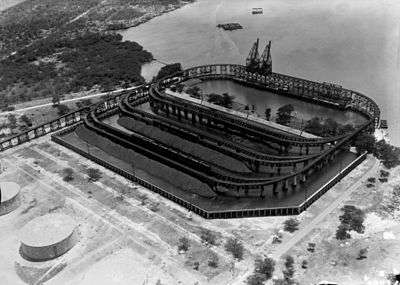Coaling (ships)
The era of the steam warship powered exclusively by coal was relatively brief, lasting from 1871 until 1914. Although the French ironclad Gloire and the iron hulled HMS Warrior in 1860 both had funnels, the purpose was to provide additional speed in battle. Sails provided the main propulsion the rest of the time so, unlike HMS Devastation, the first ship built without sails, these were not true steamships. Although much faster than sail the lengthy refueling or coaling required by steam ships brought considerable additional risk to the ship and hardship to the crew leading to the replacement of coal by oil.

The fuel itself also required maintenance. Coal cannot be pumped and once loaded, it had to be continuously moved to ensure bunkers nearest the boilers were always full should full power be suddenly needed. These problems were sufficiently serious for the Royal Navy to build HMS Queen Elizabeth as an oil-fired ship despite the abundance of coal and shortage of oil in the United Kingdom.
Necessity of nearby friendly ports
_at_coaling_station.jpg)
The replacement of sailing ships with steam led to a requirement for fuel to be widely available. Coaling a warship was a much hated, dirty and unavoidable task normally carried out in port with a collier alongside, during which time the ship was unable to fight[1] and vulnerable to attack. Once coaling had started it continued day and night until complete.[2] The denial of port facilities to the Russian Baltic Fleet, forcing them to overload themselves with coal, played a part in their defeat at Tsushima in 1905.[3] Commander Semenoff describes the problems facing the fleet required to sail around the world with very few friendly coaling ports.[4] His ship, the Borodino-class battleship Knyaz Suvorov, found all neutral ports closed, leaving it the choice of either coaling at anchor 3 miles of the coast—regarded as very risky or even impossible even in good weather—or carrying additional fuel. The Borodino class battleships—already 2.5 ft lower in the water than designed and a cause for concern even carrying their designed maximum 1100 tonnes—took on a total 2200 tonnes of coal. They even used the main deck and were regarded as potentially at risk of capsizing in a strong wind. The Suvorov coaled in 29 hours in tropical heat, the sailors keeping cotton wool between their teeth to avoid inhaling coal dust. Even so, Semenoff reckoned no-one could work for more than 20 minutes in the conditions.
Vulnerability
Warships caught coaling were stationary targets operating without power[5] and the British battlecruisers in the Falklands in 1914 were fortunate that Admiral Von Spee missed a "golden opportunity" to attack them.[6]
United States Navy procedures
The call to "Rig ship for coaling!" was an unwelcome announcement of a day of backbreaking work shoveling coal into canvas bags aboard a collier, hoisting those bags onto the warship, dumping the bags near the coal bunkers, and shoveling the coal into those bunkers. The following day was spent cleaning the warship of the black coal dust which had penetrated every crevice and corner of the ship including their living quarters and food supplies.[7]
Removing the coal dust clinging to their perspiring skin after coaling required each man to bathe sitting balanced atop the single bucket of fresh water he had been issued for the purpose. There were no showers. The deck was covered with nude sailors trying to avoid overturning his bucket while carefully washing himself over his individual bucket so the water flowing off his torso and extremities returned to the bucket for re-use. A shipmate might be asked to scrub another's back.[7]
Need for ship design changes
In 1908, Rear Admiral Sir Christopher Cradock declared that expeditious coaling was essential for the efficiency of the Navy and lamented the fact that dockyards still hadn't changed ship design specifically to facilitate it. Noting that "the question of rapid coaling appears to me to have never been really studied, and even now it is in its infancy," he said no detail should be left untouched to ensure completion in the quickest possible manner. Every single officer and man that can be spared, should get into the collier to dig out the coal. Other recommendations were that coaling was always done from the same side, that this was kept free of obstructions and that marks were made on the refueling collier so that it was easy to align the two ships in the best position. Using these techniques, the battleship HMS King Edward VII broke records receiving 1180 tons at 289.2 tons an hour.
Provision of coal supplies
In Britain, the Severn Tunnel was constructed primarily to shorten communications between the South Wales coalfield and its high quality steam coal, down to the Royal Navy dockyards around Portsmouth. Work on the tunnel began in 1873 but, owing to problems with unexpected flooding, was not completed until 1886.
References
- Christopher Cradock (1908). "Coaling Ship from a Collier". Whispers from the Fleet.
- "A sailors life in the new steel navy:working with coal". steelnavy.org. Retrieved 6 August 2013.
- "Tsushima". Russo-Japanese War Research Society. Archived from the original on 8 January 2013. Retrieved 16 August 2013.
- "Commander Vladimir Semenoff: Coaling at Sea, 1905". Modern History Sourcebook. Retrieved 2 August 2013.
- "Battle of the Falkland Islands". worldwar1. Retrieved 6 August 2013.
- "Who's Who - Sir Frederick Sturdee". firstworldwar. Retrieved 6 August 2013.
- Upchurch, Richard L. (1986). "Life in the Armored Cruisers". Proceedings. United States Naval Institute. 112 (1): 43–49.
External links
- . New International Encyclopedia. 1905.